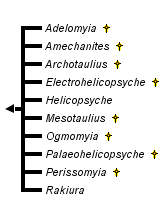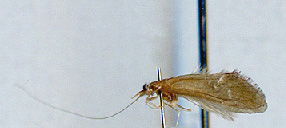Helicopsychidae
Karl Kjer


This tree diagram shows the relationships between several groups of organisms.
The root of the current tree connects the organisms featured in this tree to their containing group and the rest of the Tree of Life. The basal branching point in the tree represents the ancestor of the other groups in the tree. This ancestor diversified over time into several descendent subgroups, which are represented as internal nodes and terminal taxa to the right.

You can click on the root to travel down the Tree of Life all the way to the root of all Life, and you can click on the names of descendent subgroups to travel up the Tree of Life all the way to individual species.
For more information on ToL tree formatting, please see Interpreting the Tree or Classification. To learn more about phylogenetic trees, please visit our Phylogenetic Biology pages.
close boxIntroduction
The snail-case caddisflies of the family Helicopsychidae were first recognized as the subfamily Helicopsychinae of Sericostomatidae by Ulmer (1906) and were retained there by a number of European workers well into the 1950s, most notably Ulmer himself (Ulmer 1955). Ross (1944) and other American workers considered the group a distinct family, reflecting its current status. As presently constituted, the family contains only 2 genera, the cosmopolitan Helicopsyche von Siebold with about 250 species, and the New Zealand endemic genus Rakiura McFarlane, with a single species, R. vernale McFarlane. Several previously recognized genera, including Cochliopsyche Müller (Neotropical), Petrotrichia Ulmer (Afrotropical, including Madagascar and the Seychelles, but absent from southern Africa), and Saetotrichia Brauer (Australia, New Zealand, New Caledonia), were relegated as subgenera of Helicopsyche by Johanson (1998). In the same paper, Johanson described 2 additional subgenera of Helicopsyche: Feropsyche (Nearctic, Neotropical) and Galeopsyche (Korea, Vietnam). The nominotypical subgenus occurs in the Palearctic and Oriental regions. As a whole the family is poorly represented in the Northern Hemisphere, but reaches its greatest diversity in the tropics of the Old and New Worlds (Johanson 1997); the Neotropics alone hosts about 100 species. Taken from Holzenthal et al. (2007).Characteristics
Larvae of the genus are the familiar and remarkable snail-case builders. These helical, sand grain cases are so similar to snails that early workers described these insects as molluscs. Lea (1834) went so far as to say of Valvata arenifera (=Helicopsyche borealis), “It has the singular property of strengthening its whirls by the agglutination of particles of sand, and by which it is entirely covered.” While all helical, there is great diversity in the height of cases, the number and openness of the whorls, the size of mineral material, and the amount of silk incorporated. All helicopsychid larvae appear to feed as scrapers on periphyton and other organic matter on the exposed surfaces of rocks. They are found in slow flowing lowland streams as well as springs, small fast-flowing streams, and the wave-washed shores of lakes in temperate regions; they also occur in the hyporheic zone (Williams et al. 1983) and in thermal springs (Resh et al. 1984). The biology of the North American species, H. borealis (Hagen) is well known (Vaughn 1985a, b, 1987). Taken from Holzenthal et al. (2007).Discussion of Phylogenetic Relationships
Since Morse’s (1997) review of phylogenetic studies within the Trichoptera, Johanson has undertaken significant analyses of evolutionary relationships within Helicopsyche (Johanson 1998, 2001, 2002, Johanson & Willassen 1997). Taken from Holzenthal et al. (2007).References
Holzenthal R.W., Blahnik, R.J., Prather, A.L., and Kjer K.M. 2007. Order Trichoptera Kirby 1813 (Insecta), Caddisflies. In: Zhang, Z.-Q., and Shear, W.A. (Eds). 2007 Linneaus Tercentenary: Progress in Invertebrate Taxonomy. Zootaxa. 58 pp. 1668:639-698
Johanson, K.A. (1997) Zoogeography and diversity of the snail case caddisflies (Trichoptera: Helicopsychidae). In: Holzenthal, R.W. & Flint, O.S., Jr. (Eds.) Proceedings of the 8th International Symposium on Trichoptera. Ohio Biological Survey, Columbus, Ohio, pp. 205–212.
Johanson, K.A. (1998) Phylogenetic and biogeographic analysis of the family Helicopsychidae (Insecta: Trichoptera). Entomologica Scandinavica, Supplement, 53, 1–172.
Johanson, K.A. (2001) Phylogenetic and biogeographical analysis of the New Zealand Helicopsyche von Seibold (Trichoptera: Helicopsychidae). Insect Systematics and Evolution, 32, 107–120.
Johanson, K.A. (2002) A new primitive Helicopsyche from Madagascar (Trichoptera: Helicopsychidae), with phylogenetic analysis of Afrotropical species. Tijdschrift voor Entomologie, 145,
Johanson, K.A. & Willassen, E. (1997) Are the African species of Helicopsyche von Siebold 1856 (Insecta Trichoptera Helicopsychidae) monophyletic? Tropical Zoology, 10, 117–128.
Lea, I. (1834) Observations on the Naiades, and descriptions of new species of that and other families. Transactions of the American Philosophical Society, 4, 63–121.
Morse, J.C. (1997) Phylogeny of Trichoptera. Annual Review of Entomology, 42, 427–450.
Resh, V.H., Lamberti, G.A. & Wood, J.R. (1984) Biological studies of Helicopsyche borealis (Hagen) in a coastal California stream. In: Morse, J.C. (Ed.) Proceedings of the 4th International Symposium on Trichoptera. Dr. W. Junk, The Hague, pp. 315–319.
Ross, H.H. (1944) The caddisflies or Trichoptera of Illinois. Bulletin of the Illinois Natural History Survey, 23, 1–326.
Ulmer, G. (1906) Neuer beitrag zur kenntnis außereuropäischer Trichopteren. Notes from the Leyden Museum, 28, 1–116.
Ulmer, G. (1955) Köcherfliegen (Trichopteren) von den Sunda-Inseln. Teil II. Larven und Puppen der Integripalpia.Archiv für Hydrobiologie, Supplement, 21, 408–608.
Vaughn, C.C. (1985a) Evolutionary ecology of case architecture in the snailcase caddisfly, Helicopsyche borealis. Freshwater Invertebrate Biology, 54, 178–186.
Vaughn, C.C. (1985b) Life history of Helicopsyche borealis (Hagen) (Trichoptera: Helicopsychidae) in Oklahoma. American Midland Naturalist, 113, 76–83.
Vaughn, C.C. (1987) Substratum preference of the caddisfly Helicopsyche borealis (Hagen) (Trichoptera: Helicopsychidae). Hydrobiologia, 154, 201–205.
Williams, D.D., Read, A.T. & Moore, K.A. (1983) The biology and zoogeography of Helicopsyche borealis (Trichoptera: Helicopsychidae): a Nearctic representative of a tropical genus. Canadian Journal of Zoology, 61, 2288–2299.
Title Illustrations

| Scientific Name | Helicopsyche brazilia |
|---|---|
| Location | Minas Gerais, Brazil |
| Creator | Karl Kjer |
| Specimen Condition | Dead Specimen |
| Identified By | Ralph W. Holzenthal |
| Sex | Male |
| Life Cycle Stage | Adult |
| View | Lateral |
| Collection | Univeristy of Minnesota UMSP |
| Type | Paratype |
| Collector | Holzenthal & Paprocki |
| Source Collection | Barcode of Life Database (BOLD) |
About This Page
Karl Kjer

Rutgers University, New Brunswick, New Jersey, USA
Correspondence regarding this page should be directed to Karl Kjer at
Page copyright © 2010 Karl Kjer
 Page: Tree of Life
Helicopsychidae.
Authored by
Karl Kjer.
The TEXT of this page is licensed under the
Creative Commons Attribution-NonCommercial License - Version 3.0. Note that images and other media
featured on this page are each governed by their own license, and they may or may not be available
for reuse. Click on an image or a media link to access the media data window, which provides the
relevant licensing information. For the general terms and conditions of ToL material reuse and
redistribution, please see the Tree of Life Copyright
Policies.
Page: Tree of Life
Helicopsychidae.
Authored by
Karl Kjer.
The TEXT of this page is licensed under the
Creative Commons Attribution-NonCommercial License - Version 3.0. Note that images and other media
featured on this page are each governed by their own license, and they may or may not be available
for reuse. Click on an image or a media link to access the media data window, which provides the
relevant licensing information. For the general terms and conditions of ToL material reuse and
redistribution, please see the Tree of Life Copyright
Policies.
- First online 17 July 2010
- Content changed 20 July 2010
Citing this page:
Kjer, Karl. 2010. Helicopsychidae. Version 20 July 2010 (under construction). http://tolweb.org/Helicopsychidae/14641/2010.07.20 in The Tree of Life Web Project, http://tolweb.org/







 Go to quick links
Go to quick search
Go to navigation for this section of the ToL site
Go to detailed links for the ToL site
Go to quick links
Go to quick search
Go to navigation for this section of the ToL site
Go to detailed links for the ToL site